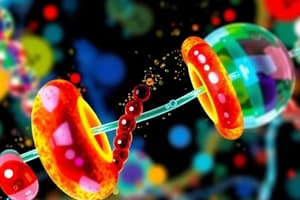Podcast
Questions and Answers
Which process converts food energy into ATP energy?
Which process converts food energy into ATP energy?
- Glycolysis
- Photosynthesis
- Fermentation
- Cellular Respiration (correct)
What is the role of chloroplasts in plants?
What is the role of chloroplasts in plants?
- To store energy in chemical bonds
- To produce oxygen
- To convert sunlight into glucose (correct)
- To convert glucose to ATP
What is the energy currency of the cell?
What is the energy currency of the cell?
- ATP (correct)
- ADP
- Glucose
- Ribose
What happens when a phosphate group is removed from ATP?
What happens when a phosphate group is removed from ATP?
How is ATP used in the cell?
How is ATP used in the cell?
Which molecule is converted to ATP in cellular respiration?
Which molecule is converted to ATP in cellular respiration?
What is the function of chloroplasts in plants?
What is the function of chloroplasts in plants?
What is the role of mitochondria in cellular respiration?
What is the role of mitochondria in cellular respiration?
What happens when a phosphate group is removed from ATP?
What happens when a phosphate group is removed from ATP?
How is ATP used in the cell?
How is ATP used in the cell?
Flashcards are hidden until you start studying
Study Notes
Energy Conversion Processes
- Cellular respiration converts food energy, primarily from glucose, into ATP energy.
- ATP (adenosine triphosphate) serves as the primary energy carrier in cells.
Role of Chloroplasts
- Chloroplasts are the sites of photosynthesis in plant cells, where sunlight is converted into chemical energy.
- They contain chlorophyll, which captures light energy, driving the synthesis of glucose from carbon dioxide and water.
Energy Currency of the Cell
- ATP is known as the energy currency of the cell due to its role in storing and transferring energy for various cellular processes.
Phosphate Group Removal from ATP
- When a phosphate group is removed from ATP, the molecule is converted to ADP (adenosine diphosphate), releasing energy for cellular activities.
- This process is known as hydrolysis and is vital for energy metabolism.
Usage of ATP in Cells
- ATP is utilized in numerous cellular functions, including muscle contraction, transport of molecules across membranes, and biochemical reactions.
- It provides the energy necessary for processes such as biosynthesis and cell signaling.
Cellular Respiration and ATP Production
- Glucose is the primary molecule converted into ATP during cellular respiration.
- This process involves glycolysis, the Krebs cycle, and oxidative phosphorylation, ultimately producing ATP through the breakdown of glucose.
Function of Mitochondria
- Mitochondria play a crucial role in cellular respiration by converting nutrients into ATP.
- They are known as the powerhouse of the cell, facilitating the production of ATP through aerobic respiration.
Studying That Suits You
Use AI to generate personalized quizzes and flashcards to suit your learning preferences.




